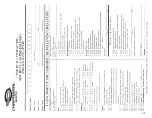
suring the air temperature and dew point temperature. If the differ-
ence between these two temperatures is small, fog is likely to
develop. Remember the following guidelines:
•
Turn on running lights.
•
Unless your boat is well equipped with charts, head for shore at
the first sign of fog and wait until conditions improve. If you have
charts on board, take bearings as fog sets in, mark your posi-
tion, and continue to log your course and speed.
•
Make sure all persons on board have put on their personal flota-
tion devices.
•
If your boat has sounding equipment, take soundings regularly
and match them with depths shown on your charts.
•
Station a person forward in the boat as a lookout.
•
Reduce your speed. From time to time, stop engine(s) and listen
for other fog signals.
•
Sound the horn or fog bell intermittently to warn others.
•
If there is any doubt in continuing your excursion, anchor. Listen for
other fog signals while continuing to sound your fog horn or bell.
Storms
The present and forecasted weather conditions are a primary con-
sideration, and the possibility of storms should always be a concern.
If storms are a possibility, keep a watch on the horizon, especially to
the west, for approaching storms. Monitor the weather forecast on a
marine channel or local weather station. The best possible situation
is to return to a safe port if time allows.
Other steps to follow to weather the storm include:
•
Close and secure port holes. Stow all loose gear below deck
and tie down any gear on deck.
•
Reduce speed as the seas build. Make sure all persons on
board have put on their personal flotation devices.
•
Trail a sea anchor from the bow. If you do not have a sea anchor
aboard, use a canvas bucket, tackle box, or other object that will
work like a sea anchor.
•
Radar reflectors (if installed on your boat) should be 18 inches
diagonally. They should be placed as far above waterline as
possible. Otherwise, a boat with radar may have trouble “see-
ing” your boat.
Man Overboard
Should someone in the boat fall overboard:
•
Act quickly—treat every situation as an emergency.
•
Move throttle to idle position and yell “Man Overboard”.
•
Immediately throw a Type IV PFD to the person in the water.
•
Have someone in the boat assume responsibility for watching
the person in the water and keep them in sight while the boat
maneuvers back to them.
•
Approach the person into the wind and waves. When alongside,
put the engine in neutral and throw them a Type IV PFD with a
line attached or extend an oar or boat hook.
Fire
Important: A fire aboard your boat is a serious emergency. You
must act immediately!
Every boater should develop a fire response plan to determine what
kind of fire (fuel, electrical, etc.) might break out, where it might break
out, and the best way to react. Having a plan and assigning respon-
sibilities to others results in quicker decisions and quicker reactions.
2-6
Содержание SSX-236
Страница 1: ...S S X 2 3 6 2 5 6 2 7 6 2 0 0 9 O W N E R O P E R AT O R M A N U A L...
Страница 2: ......
Страница 4: ......
Страница 17: ...1 7...
Страница 18: ......
Страница 22: ......
Страница 24: ......
Страница 40: ...2 16...
Страница 52: ...3 12...
Страница 80: ...5 16...
Страница 98: ......
Страница 106: ......
Страница 112: ......
Страница 113: ...WIRING SCHEMATICS 12 12 1 236 SSX...
Страница 114: ...12 2 236 SSX...
Страница 115: ...12 3 256 SSX...
Страница 116: ...12 4 256 SSX...
Страница 117: ...12 5 276 SSX...
Страница 118: ...12 6 276 SSX...
Страница 119: ......
















































